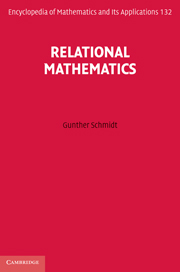Book contents
- Frontmatter
- Contents
- Notes on illustrations
- Preface
- 1 Introduction
- PART I REPRESENTATIONS OF RELATIONS
- PART II OPERATIONS AND CONSTRUCTIONS
- PART III ALGEBRA
- PART IV APPLICATIONS
- PART V ADVANCED TOPICS
- Appendix A Notation
- Appendix B Proofs postponed from Part II
- Appendix C Algebraic visualization
- Appendix D Historical annotations
- References
- Symbols
- Index
PART V - ADVANCED TOPICS
Published online by Cambridge University Press: 05 May 2013
- Frontmatter
- Contents
- Notes on illustrations
- Preface
- 1 Introduction
- PART I REPRESENTATIONS OF RELATIONS
- PART II OPERATIONS AND CONSTRUCTIONS
- PART III ALGEBRA
- PART IV APPLICATIONS
- PART V ADVANCED TOPICS
- Appendix A Notation
- Appendix B Proofs postponed from Part II
- Appendix C Algebraic visualization
- Appendix D Historical annotations
- References
- Symbols
- Index
Summary
Beyond what has been shown so far, there exist further fascinating areas. One of these is concerned with relational specification. While standard relation algebra formulates what has to be related, here only a region is circumscribed within which the relation envisaged is confined. Although this area has attracted considerable interest from researchers, we omit the presentation of demonic operators used for it.
We continue by mentioning what we cannot present here. With relational grammar applied to natural languages, it has been shown that the translation of relations of time, possession, or modality, for example, can be handled when translating to another natural language. Spatial reasoning has long used relation algebra in order to reason about the relative situatedness of items. This is directed at real-time scanning of TV scenes.
One of the application areas that we present may not be seen as an application in the first place. We also use relations to review parts of standard mathematics, the homomorphism and isomorphism theorems. Additional results may be reported and deeper insights gained when using relations. This area seems particularly promising because many other such reconsiderations may be hoped for. We show possible directions to encourage further research with the Farkas Lemma, topology, projective geometry, etc.
Implication structures study long-range implications, preferably with only a few alternatives; they are helpful in investigating dependency situations. This makes the examples of Sudoku and timetables interesting.
Information
- Type
- Chapter
- Information
- Relational Mathematics , pp. 439 - 440Publisher: Cambridge University PressPrint publication year: 2010
